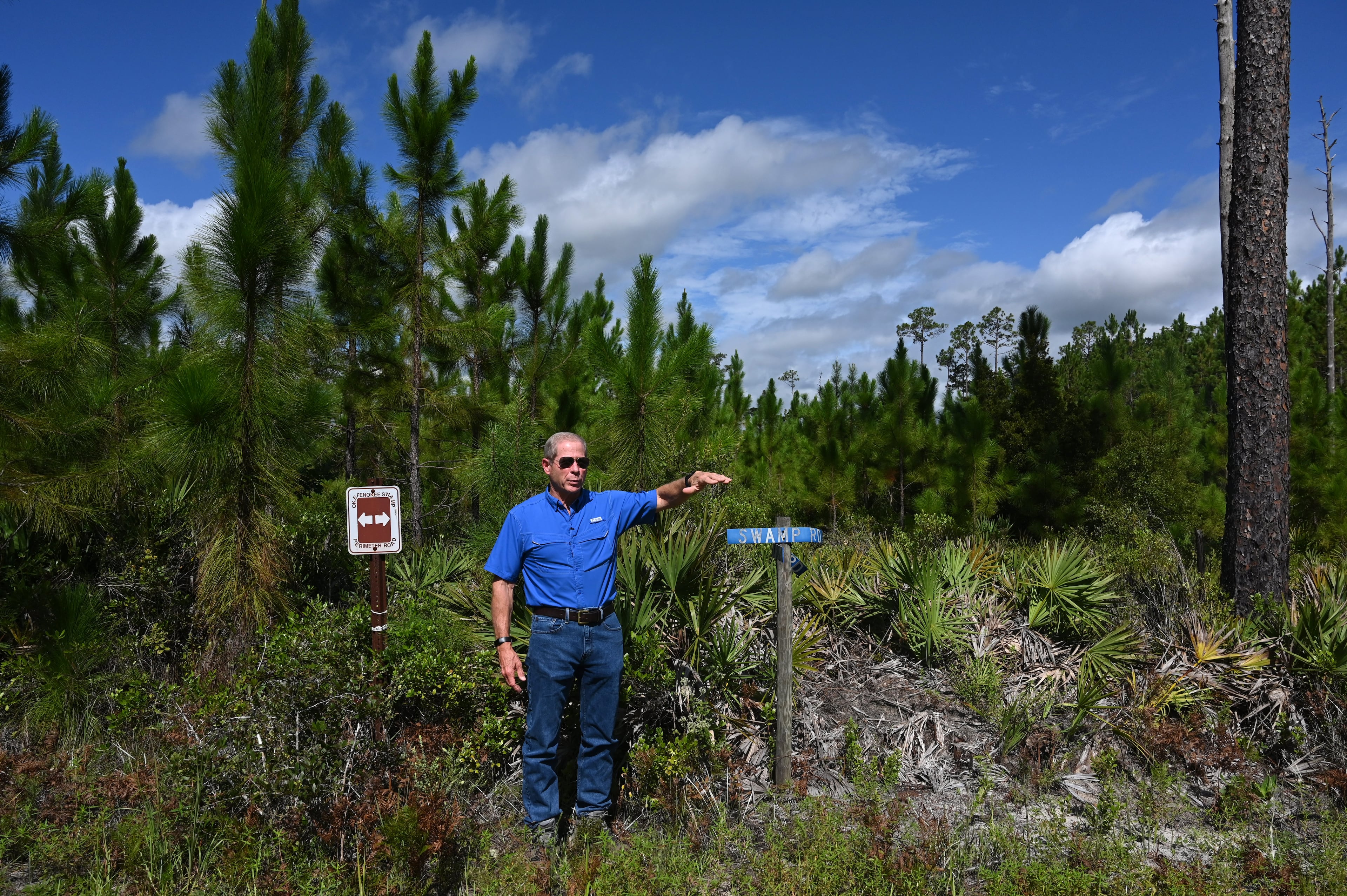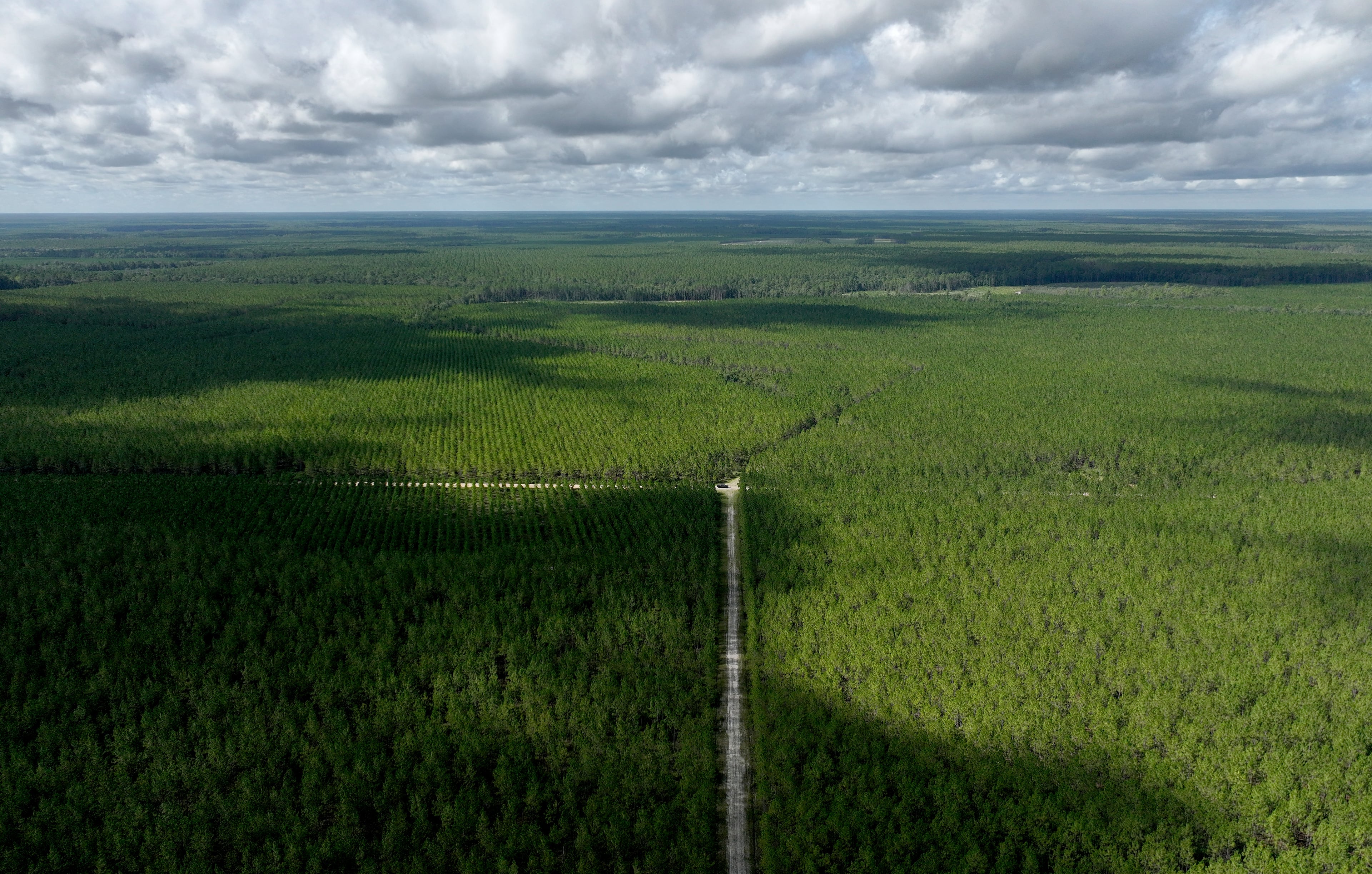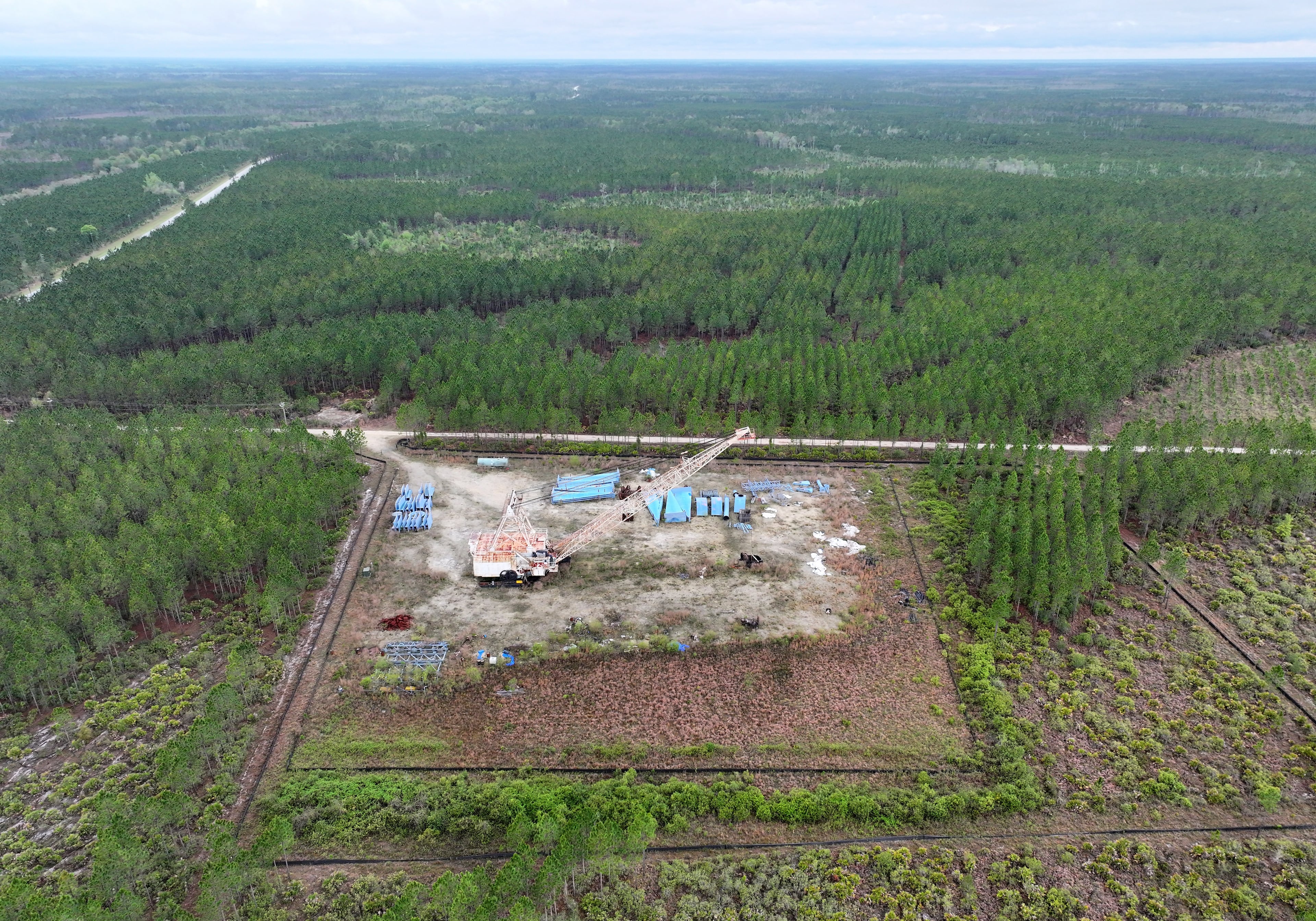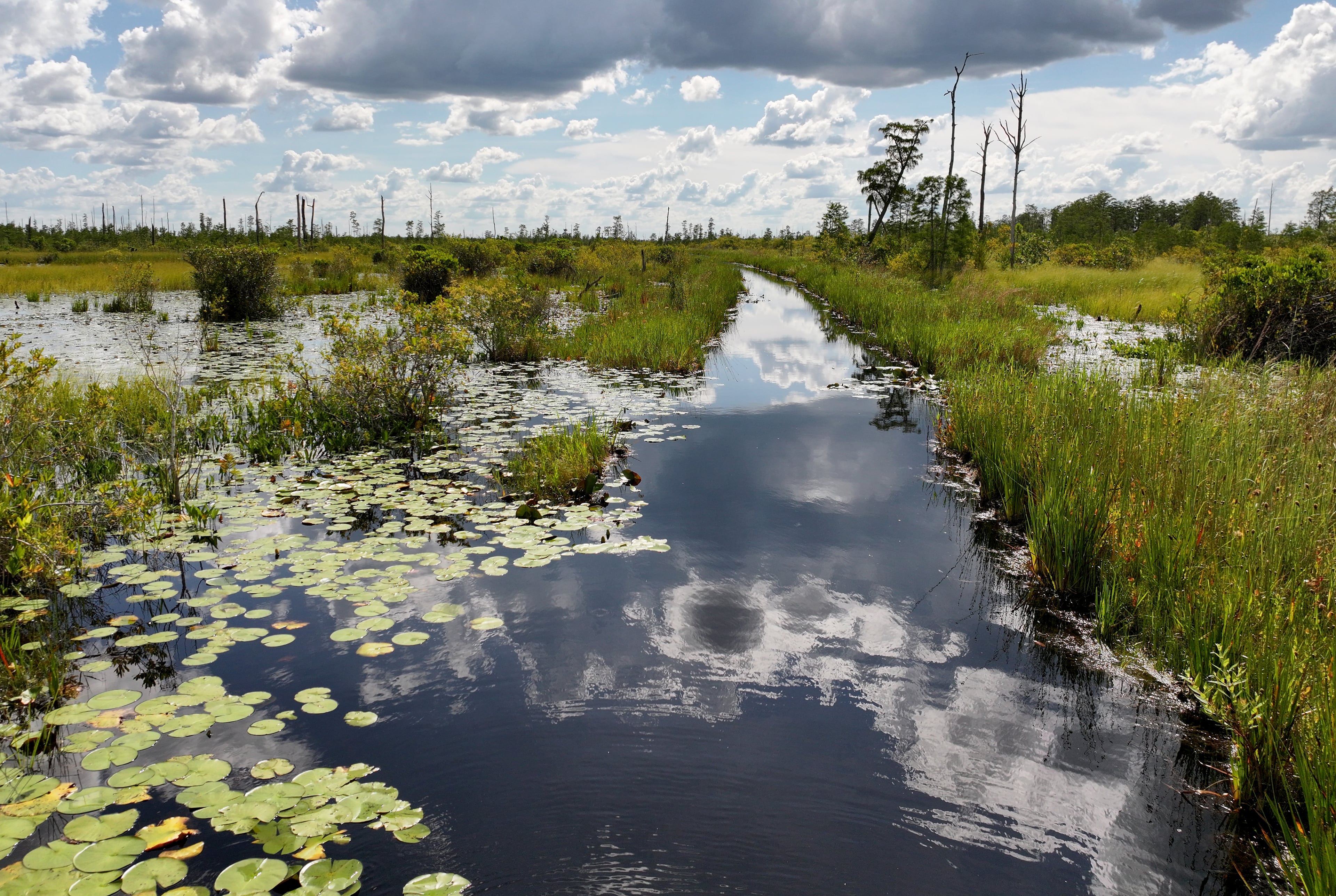The Okefenokee Swamp is safe for now, but talk of mining near it hasn’t stopped

FOLKSTON — On a blast furnace of an August day in Georgia’s southernmost county, Joe Hopkins gripped the steering wheel to steady his truck on the sandy road.
Outside, seemingly endless rows of neatly spaced trees whizzed by — mostly slash pine, the species of choice for foresters in this part of the state.
Hopkins’ family has been growing timber here near the eastern rim of the Okefenokee Swamp for more than 100 years. In this maze of trees, Hopkins remembers where he killed his first deer, and where his son claimed his first turkey.
“My life is out here,” he said.
The business his great-uncle co-founded is known today as Toledo Manufacturing Co. and has since amassed roughly 50,000 acres in Charlton County, making it one of the largest landowners here. At the western edge of Toledo’s largest tract, pine trees give way to cypress and the wilderness of the Okefenokee National Wildlife Refuge.
For now, Toledo’s properties are managed for commercial timber, like they have for decades. But Hopkins says his margins are getting tighter and he wants to keep his options open for making money off the land. That includes exploring mining the sandy soils — if it can be done safely.
“I would like to mine our deposit if it can be done without harming the Okefenokee Swamp,” Hopkins said.

This summer, the nonprofit The Conservation Fund paid $60 million to acquire about 8,000-acres near the swamp’s southeast corner, where the Alabama firm Twin Pines Minerals had planned to mine titanium-rich sands.
The deal was celebrated as a rare conservation win. It spelled an end to a proposal some scientists, environmentalists and outdoorsmen called an existential threat to the Okefenokee, one of the largest intact wetland ecosystems left on Earth.
But the end of that project hasn’t silenced talk of mining on the Okefenokee’s doorstep.
Mineral-rich sands that have attracted mining companies to the area for decades remain beneath the pines that border the swamp. Large chunks of forest land are still privately owned, both by Hopkins’ company and other firms that could someday try to harvest the riches. And to date, legislation that could keep mining away from the Okefenokee has failed to pass Georgia’s General Assembly.
Local leaders say the small towns encircling the swamp need to offer residents jobs to survive.
Some say mining could be part of the solution to the area’s woes. Others envision a future built around the natural wonder in their backyard and see the Okefenokee’s bid to join the prestigious UNESCO World Heritage list as the pillar of a sustainable tourist economy.
Conservationists have been here before.
In the 1990s, the materials giant DuPont tried to mine near the swamp, before environmentalists and the federal government quashed those plans. Then, more than two decades later, Twin Pines emerged with a mining plan that nearly won state approval and in some ways caught mining opponents off guard.
Now, they’re determined not to let history repeat itself.
“I think everybody involved this time around is committed to making sure the Okefenokee is protected for good,” said Megan Huynh, a senior attorney at the Southern Environmental Law Center.
Shifting sands and mineral riches
Earth has gone through natural warming and cooling cycles throughout its history. Those shifts help explain why the fringe of North America’s largest blackwater swamp keeps drawing mining interest.
When the planet was even hotter than today, sea levels were higher and most of Southeast Georgia was under water. During colder periods, large ice sheets and glaciers formed toward the poles, sending the ocean into retreat.
Relics of the dramatic rise and fall in sea levels still exist today in the form of inland sand dunes and barrier islands. They can be found in places as far flung as Australia, Brazil and next door to the Okefenokee.
On the east side of the swamp, winds left a line of ancient sand dunes stretching roughly 100 miles from North Florida into parts of several Southeast Georgia counties.

Today, the formation is known as Trail Ridge.
On the ground, Trail Ridge blends into the rest of Georgia’s flat coastal plain, its gradual slope mostly concealed by commercial timberlands. The only hint of the mineral riches it contains are the beachlike white sands beneath the trees.
U.S. Geological Survey reports from at least the 1940s noted the sand layers may have “commercial value.” A later 1989 USGS report said Trail Ridge was probably home to the “the most valuable single resource of titanium minerals in the United States.”
Parts of Trail Ridge have been mined for decades.
Since the 1940s, E.I. Du Pont de Nemours and Co. and its spinoffs have mined the sands in North Florida. Starting in the mid-1960s, the Humphreys Mining Co. mined a portion in Georgia 7 miles from the Okefenokee National Wildlife Refuge. Today, a subsidiary of Chemours — a DuPont spinoff — mines a stretch farther from the swamp in Charlton and Brantley counties.

Mining companies believe parts of Trail Ridge still hold large amounts of untapped minerals.
The purest titanium can be used for aerospace parts and high-heat machinery, but the overwhelming majority is consumed as titanium dioxide, a whitening agent found in toothpaste and paint, according to a USGS report.
Responding to audience questions after a presentation at the Georgia Association of Conservation Districts’ annual meeting this summer, a Chemours representative said Trail Ridge contains the country’s last big mineral sand deposit.
“We can decide not to mine it, but we have to recognize that all production will end up being offshore after about 20 years,” said Jim Renner, an environmental stewardship manager for Chemours.

A natural dam
But Trail Ridge is also vital to the Okefenokee.
U.S. Fish and Wildlife Service and University of Georgia experts say the dunes serve as a natural dam that helps hold water in the swamp.
“There should be drainage from the west and the north to the east and the south, but those paths are blocked by Trail Ridge,” said Rhett Jackson, a hydrologist and UGA professor. “Water just backs up there (in the Okefenokee), making the swamp.”
Environmentalists and many scientists feared Twin Pines’ mine pit on Trail Ridge would harm the swamp.
Most worrying to Jackson was its planned water use.
On top of pumping as much as 1.5 million gallons of groundwater a day, the mine would have had to constantly remove water that seeped into its 50-foot-deep pit so equipment could sift the sands. But instead of returning the water to the ecosystem, Twin Pines planned to use enormous evaporators to send it into the humid, South Georgia air.
Twin Pines insisted its plans were safe.
But the Okefenokee is a shallow, mostly rain-fed system that’s susceptible to drought. It contains huge amounts of decaying plant matter know as peat, as deep as 15 feet in parts. As long as the peat stays wet, it keeps millions of tons of greenhouse gases locked safely away. If it dries out, it can burn and smolder for months — all while worsening global warming.

Jackson argued the mine would increase the frequency of wildfires.
That a vast wetland is prone to fire seems counterintuitive, but some of Georgia’s worst blazes on record have started in the Okefenokee. Georgia’s largest, the 2007 Bugaboo Scrub Fire, which scorched more than half-a-million acres, began in the swamp.
Larry Woodward, the Okefenokee National Wildlife Refuge’s deputy manager, said fire is a natural part of the ecosystem, helping cycle nutrients through the swamp. When it spills into surrounding commercial timberlands, it becomes a problem.
“Our whole goal in fire management is to keep fires away from our neighbors,” Woodward said.

‘A living laboratory’
One of those neighbors, Hopkins, has been on conservationists’ radar for years.
In the 1990s, Hopkins’ company leased 23,000 acres to DuPont, but the company backed off plans to mine after intense backlash, first from environmentalists, then the federal government.
Hopkins returned to the spotlight more recently after Twin Pines revealed its plans.
Some environmentalists speculated that if Twin Pines obtained permits, an even larger project could follow on Toledo’s land. Appearances at legislative hearings by Hopkins, a staunch backer of property rights, to oppose bills that would have blocked mining on his land sparked more theories.
Today, Hopkins says he doesn’t have agreements in place to mine his land and insists he isn’t pursuing any. But, he is still interested in mining on Trail Ridge, if it can be done without hurting the swamp. He remains unconvinced it would doom the refuge, as some claim.
Hopkins says he’d like to see an independent study investigate the feasibility of mining near the refuge.
“We’ve got a living laboratory,” he said.

Other large landowners on Trail Ridge and companies that have mined other parts of the formation say they have no plans to pursue mines near the swamp, for now.
Chemours has mined Trail Ridge in Florida and has an active mine in the north end of Charlton County. Jess Loizeaux, a spokeswoman for Chemours, said the company has no mining agreements in place along the Okefenokee’s eastern flank.
Chemours has, however, supported mining research.

The company contributed funding for a 2022 study to develop a model for assessing “hydrologic effects from mining in Southeast Georgia,” including near the Okefenokee. Last year, Chemours funded another project to advance understanding of the area’s water flows.
Loizeaux said the research is part of Chemours’ commitment to “responsible mining,” adding the studies were about the broader, regional water dynamics. But a description of the research notes a “particular focus” on how mine operations “may influence the hydrologic characteristics of Trail Ridge and the Okefenokee Swamp,” among other related goals.
Asked whether it’s interested in developing future mines on Trail Ridge, Loizeaux pointed to a company statement from 2022. In it, Chemours said it has “no plans to open new mining locations on Trail Ridge in Georgia next to the Okefenokee,” but stopped short of making a permanent commitment not to mine the area.
The statement adds the company believes its existing Georgia and Florida mines can “sustain operations well into the 2030s.”
The wood products and land management company Rayonier also owns timberlands scattered throughout Charlton County, including a 31,000-acre tract on portions of Trail Ridge.
In a statement, Rayonier said it has no “pending lease or sale agreements” on its properties near the Okefenokee, but added that it has “considered conservation sales in the past.”

‘They … don’t come back’
The economic fortunes of Charlton County and its county seat, Folkston, also help explain why talk of mining won’t go away.
Folkston sat on the old “Dixie Highway,” the country’s first major north-south highway network, which stretched from Canada to Miami. The route made travel from the northern U.S. to Florida’s beaches a much faster endeavor. Along the artery, small lodges and hotels flourished to serve vacationers.
But starting in the 1950s, the construction of I-95 and other, larger highways offered a quicker path to the Sunshine State. Towns fortunate to be on the new thoroughfare thrived. Others, like Folkston, were not so lucky.

Today, most of Folkston’s motels — throwbacks to the Dixie Highway’s heyday — are in varying states of disrepair. The county’s only hospital closed more than a decade ago and sits shuttered behind a new gas station. County officials say two of the area’s largest employers are a landfill and an Immigration and Customs Enforcement detention center.
Recent research shows deaths are outpacing births in 94 of Georgia’s 159 counties, including Charlton. Charlton’s median household income is 35% below that of the state.
“People that grow up in Charlton County … they go off to college and don’t come back,” said Glenn Hull, the county administrator.
If it’s proven it can be done safely, Hopkins thinks mining could help reverse the area’s fortunes.
“Why don’t we provide those jobs in this community?” Hopkins said. “Why don’t we provide that tax base?”
Critics say Hopkins is only interested in mining to enrich himself.
“Hopkins continues to argue, without any justification, that mining can be done safely,” said Josh Marks, the president of Georgians for the Okefenokee and a longtime mining opponent. “Why? So that he can become exponentially wealthier than he already is.”
Hopkins said he has a stake in his company, but is not the owner and has stockholders to look after, too. He says some are elderly widows.
“What difference does it make what my financial position is?” Hopkins said.
The World Heritage bump
Other lifelong residents have a different vision.
Dixie McGurn, a former mayor of Folkston who owns the Whistlin’ Dixie Cafe on Main Street and nearby Railside Lodging, sees tourism as a more sustainable job creator.
“Tourism dollars spread all over,” McGurn said. “It doesn’t stay in one little pocket.”

The Okefenokee is already a significant tourist destination, averaging more than 800,000 visitors annually and injecting an estimated $92 million into local economies, according to a report produced by The Conservation Fund. Many think that just scratches the surface of the swamp’s potential.
Last year, the refuge was nominated by the U.S. for a spot on the UNESCO World Heritage List, an honor reserved for the planet’s most iconic natural and cultural treasures.
Today, there are 1,248 sites globally with World Heritage designation, including 26 in the U.S. If selected, the Okefenokee would join world-renowned sites like Yellowstone National Park, Peru’s Machu Picchu and Australia’s Great Barrier Reef. It would also be the U.S.’ first National Wildlife Refuge to be enshrined.
The Okefenokee’s nomination will be considered next summer by the World Heritage Committee.

Kim Bednarek, the executive director of the Okefenokee Swamp Park in Waycross and Okefenokee Adventures in Folkston, is confident about the refuge’s chances. She acknowledges it will take a “mosaic” of opportunities to lift small towns around the swamp, but believes the status could offer a shot in the arm. The same Conservation Fund report projects that with the designation, the Okefenokee can expect visitation to grow to 1.4 million to 1.6 million visitors a year, creating 700 new jobs.
Bednarek, part of the leadership team behind the push to inscribe the Okefenokee, sees the swamp’s relative proximity to coastal Georgia, Jacksonville and Florida’s beaches as assets that haven’t fully been tapped into.
“Why can’t some of those folks take a drive over to the Okefenokee, have lunch in a restaurant, visit a gift shop and take a tour of the swamp?” she said. “To me, it really isn’t far-fetched.”
Searching for ‘durable’ protections
As the dust settles after a bruising, six-year fight over the Twin Pines mine, key players are plotting their next moves.
Right now, there are no new legal or legislative guardrails in place to prevent another company from pursuing mining permits.
Bills to permanently or temporarily bar mining on Trail Ridge have earned significant support under the Gold Dome, but none have received backing from key lawmakers needed to cross the finish line.
Environmentalist Christian Hunt says the coalition he chairs, the Okefenokee Protection Alliance, is focused on securing “durable” protections for the swamp — through legislation, land acquisitions and other conservation tools.
In South Georgia, as sawmills close or cut capacity, Hopkins is also thinking about his future.
Timber prices have been down, a problem made worse by the destruction from Hurricane Helene. At the same time, Hopkins says his costs are climbing.

“It’s getting more and more difficult to make a living selling pine trees,” he said.
Jackson, the UGA hydrologist, said the future of the Okefenokee may ultimately come down to simple economics.
“There’s going to come a time when all of a sudden, those mineral sands are a lot more valuable than they are right now,” Jackson said. “And when that happens, someone’s going to want to build a mine.”
— Staff writer Emma Hurt contributed to this report.
A note of disclosure
This coverage is supported by a partnership with Green South Foundation and Journalism Funding Partners. You can learn more and support our climate reporting by donating at AJC.com/donate/climate.



